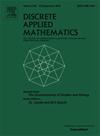构造k-置换泛环的有效方法
IF 1
3区 数学
Q3 MATHEMATICS, APPLIED
引用次数: 0
摘要
对于n-集合{1,2,…,n}的所有k-置换的集合,我们给出了两种构造泛环的有效方法,对于n>;k≥3。这两种方法利用环连接法,在反馈函数为f(x0,x1,…,xk−1)=x0的纯循环寄存器上生成k-置换的泛环。在这里,我们设计了两类后继规则,它们建立在Gabric等人(2020)提出的框架之上,每一类规则都为k-置换产生n - k移位不等价泛循环。每个k-置换的通用循环可以在O(n)个符号的O(n)个时间内使用O(n)个空间生成。本文章由计算机程序翻译,如有差异,请以英文原文为准。
Efficient methods of constructing universal cycles for k-permutations
We present two efficient methods of constructing universal cycles for the set of all -permutations of the -set for . These two methods generate universal cycles for -permutations from pure cycling registers with feedback function , using the cycle joining method. Here we design two classes of successor rules that build upon a framework proposed by Gabric et al. (2020), each of which produces shift inequivalent universal cycles for -permutations. Each universal cycle for -permutations can be generated in time per symbol using space.
求助全文
通过发布文献求助,成功后即可免费获取论文全文。
去求助
来源期刊

Discrete Applied Mathematics
数学-应用数学
CiteScore
2.30
自引率
9.10%
发文量
422
审稿时长
4.5 months
期刊介绍:
The aim of Discrete Applied Mathematics is to bring together research papers in different areas of algorithmic and applicable discrete mathematics as well as applications of combinatorial mathematics to informatics and various areas of science and technology. Contributions presented to the journal can be research papers, short notes, surveys, and possibly research problems. The "Communications" section will be devoted to the fastest possible publication of recent research results that are checked and recommended for publication by a member of the Editorial Board. The journal will also publish a limited number of book announcements as well as proceedings of conferences. These proceedings will be fully refereed and adhere to the normal standards of the journal.
Potential authors are advised to view the journal and the open calls-for-papers of special issues before submitting their manuscripts. Only high-quality, original work that is within the scope of the journal or the targeted special issue will be considered.
 求助内容:
求助内容: 应助结果提醒方式:
应助结果提醒方式:


